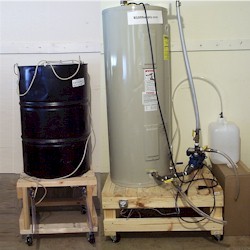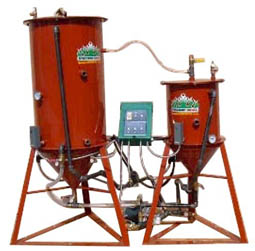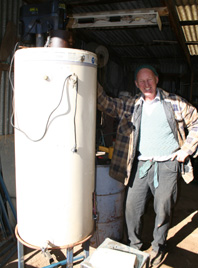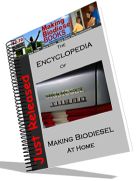How To Make Biodiesel -Introduction
 Biodiesel is generally made using chemicals to alter an organic oil by using a catalyst and an alcohol (most people use ethanol ormethanol). Ethanol is less dangerous although methanol is not as expensive. For the catalyst, sodium hydroxide (caustic soda) or potassium hydroxide can be used, although sodium hydroxide is often cheaper. The process of converting oil to biodiesel is called Transesterification. The chemical reaction that occurs during this process “cracks” the oil into Esters and Glycerol. As the process occurs the glycerine gravitates to the bottom of the container leaving alkyl esters, the glycerol is then drained off and the remaining top liquid is biodiesel. The biodiesel is often then washed to remove any remaining impurities and can then used to fuel an unmodified diesel engine.
Biodiesel is generally made using chemicals to alter an organic oil by using a catalyst and an alcohol (most people use ethanol ormethanol). Ethanol is less dangerous although methanol is not as expensive. For the catalyst, sodium hydroxide (caustic soda) or potassium hydroxide can be used, although sodium hydroxide is often cheaper. The process of converting oil to biodiesel is called Transesterification. The chemical reaction that occurs during this process “cracks” the oil into Esters and Glycerol. As the process occurs the glycerine gravitates to the bottom of the container leaving alkyl esters, the glycerol is then drained off and the remaining top liquid is biodiesel. The biodiesel is often then washed to remove any remaining impurities and can then used to fuel an unmodified diesel engine.
It is worth noting that pure biodiesel can dissolve natural rubber hoses and seals. Most new diesel engines have synthetic hoses and seals, but older engines may need to fitted with new hoses and seals. Diesel injector pumps don’t generally have rubber parts indirect contact with the fuel, so it is usually easy to replace hoses and seals without any major hassles. If a diluted fuel mixture of 20% biodiesel and 80% petroleum diesel (called “B20”) is used it should have no effect on the older natural rubber hoses.
It is often recommended to make biodiesel from fresh oil to gain an understanding and appreciation of the processes before moving onto making bigger batches from waste oils. Biodiesel typically takes a couple of days to a week from start to finish to making a batch. Most people making biodiesel make anywhere between 20 to 100 gallons at a time in a batch process.
Here’s a breakdown of typical timing intervals from start to finish:
- START
- Collect Oil – 1-2 hours
- Filter Oil – 1-2 hours (depends on amount of oil)
- Titration Of Oil – 10-15 minutes
- Transferring Oil To Processor – 10-20 minutes
- Heating Oil – 1-4 hours (depends on amount of oil, voltage & wattage of element)
- Making Methoxide – 5-20 minutes (depends on amount of methanol and catalyst used)
- Mixing Methoxide Into Oil – 20-30 minutes
- Mixing Oil & Methoxide – 2-3 hours
- Settling Oil – 8-10 hours (usually overnight)
- Draining Glycerine – 5-10 minutes
- Transferring Biodiesel To Wash Tank -10-20 minutes
- First Mist Wash – 2-3 hours
- Second Mist Wash – 2-3 hours
- First Bubble Wash – 6-8 hours (usually overnight)
- Second Bubble Wash – 6-8 hours (usually overnight)
- Transferring Biodiesel To Drying Containers– 10-20 minutes (depends on amount)
- Drying Biodiesel – 2 hours to 1 week(depends heavily on weather and amount made)
- Transferring To Storage Containers -10-20 minutes (depends on amount)
- FINISH
Equipment
 Bio diesel can be made in anything from a small 2 litre drink bottle to an elaborate processor complete with separate tanks for processing,washing, methoxide mixing, settling, and filtering. Obtaining equipment is relatively easy. Complete processing equipment can be custom made using plans off of the web or by buying pre-made kits ready to assemble. Most people get started by making small batches with minimal equipment and then gradually move up to making large batches using large processors built specifically for making biodiesel.
Bio diesel can be made in anything from a small 2 litre drink bottle to an elaborate processor complete with separate tanks for processing,washing, methoxide mixing, settling, and filtering. Obtaining equipment is relatively easy. Complete processing equipment can be custom made using plans off of the web or by buying pre-made kits ready to assemble. Most people get started by making small batches with minimal equipment and then gradually move up to making large batches using large processors built specifically for making biodiesel.
Many home brewers either buy a variety of pre made processors designed for processing biodiesel or custom make their own processors either from kits or from plans on the web. Professionally built processors can cost as little as $500 to several thousands of dollars.Kits can be purchased for making your own from several online retailers for as little as $200 on up to elaborate systems complete with methanol recovery condensers.
Instructions on How to Make Biodiesel
 This idea needs to be said again… Start with the process, not with the processor. The processor like the 250 litre (66 gallons) home made unit on the left comes later. Start with fresh unused oil, not with waste vegetable oil (WVO) that also comes later. Understand the process, start by making a small, 1-litre test batch of bio diesel using fresh new oil.You can use a spare blender, or, better, make a simple Test-batchmini-processor. Keep going, step by step. Study everything you can. One of the best resources on the Web for detailed instructions (it is free) is a site called Journey to Forever.
This idea needs to be said again… Start with the process, not with the processor. The processor like the 250 litre (66 gallons) home made unit on the left comes later. Start with fresh unused oil, not with waste vegetable oil (WVO) that also comes later. Understand the process, start by making a small, 1-litre test batch of bio diesel using fresh new oil.You can use a spare blender, or, better, make a simple Test-batchmini-processor. Keep going, step by step. Study everything you can. One of the best resources on the Web for detailed instructions (it is free) is a site called Journey to Forever.
Definitive Guide- The Encylopedia of Making Biodiesel
 The Encylopedia of Making Biodiesel is without doubt the best book on the market (and we have looked at plenty) on how tomake biodiesel. David and Tram are the Managing Directors of International Biofuel Solutions, and David is a lecturer at technical universities in both Vietnam and Thailand. Over 200 pages of step-by-step instructions with dozens of illustrations, drawings and photographs to assist you. Whether you are just starting out or a bio diesel pro, this book is really a must!
The Encylopedia of Making Biodiesel is without doubt the best book on the market (and we have looked at plenty) on how tomake biodiesel. David and Tram are the Managing Directors of International Biofuel Solutions, and David is a lecturer at technical universities in both Vietnam and Thailand. Over 200 pages of step-by-step instructions with dozens of illustrations, drawings and photographs to assist you. Whether you are just starting out or a bio diesel pro, this book is really a must!
Biodiesel Recipes
Some links to detailed methods when thinking about how to make biodiesel.
- Kitchen-Biodiesel based off of Tilly’s World Famous Dr. Pepper Method.
- World Famous Dr. Pepper Method – Part 1 Part I of a recipe for making a small batch of Biodiesel in a Dr.Pepper bottle. Followed by many the first time they make biodiesel.
- World Famous Dr. Pepper Method – Part 2 Part II for finishing up the batch made in the Dr. Pepper bottle.
- Dangerous Laboratories Great instructions for making a batch of Biodiesel for the first time.Complete with pictures and detailed instructions.
|
Biomass Technologies
Landfill Gas What is Biofuel? Palm Oil Biodiesel Biodiesel from Algae Make Algae Biodiesel at Home Ethanol Biofuel Biofuel Ethics Wood Gas Generator
|
